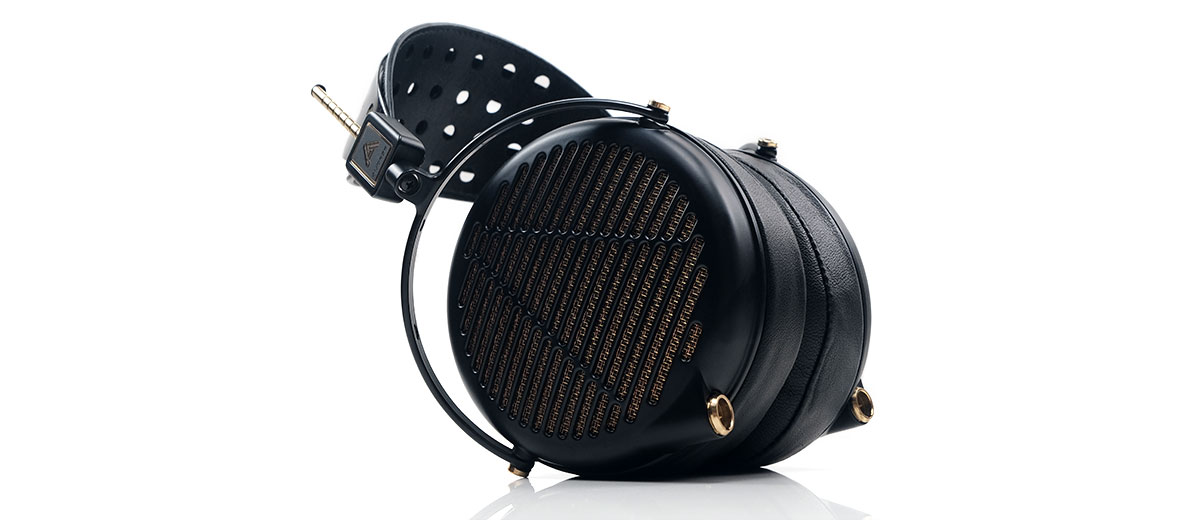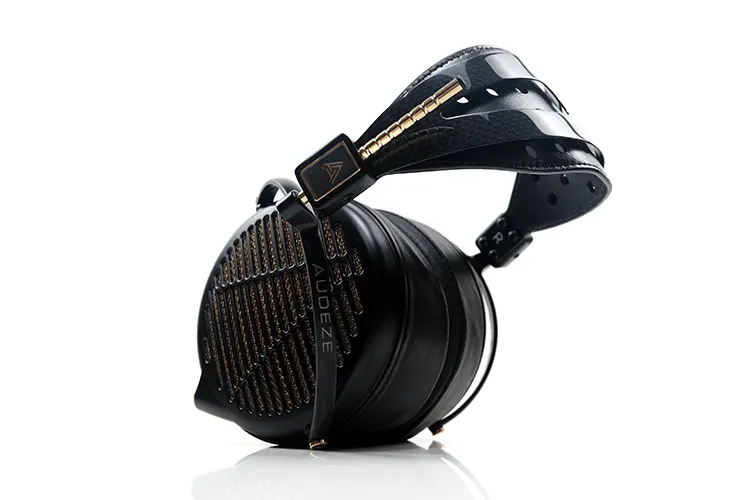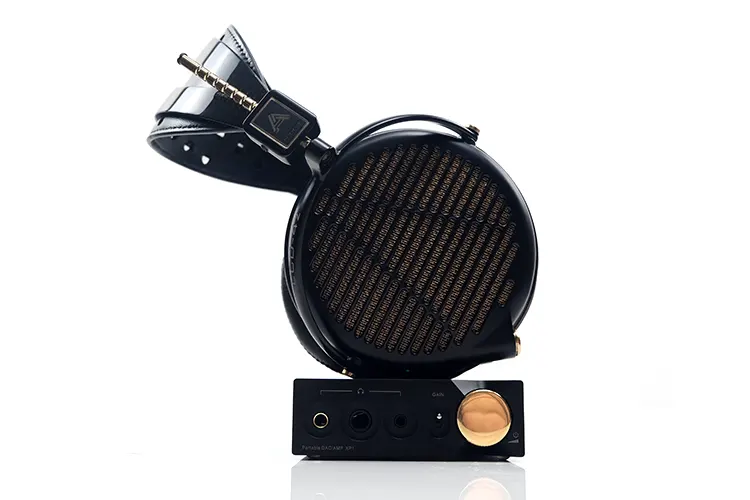Sound Impressions
The following sound impressions were completed using a mix of the Ferrum OOR/HYPSOS combo with a balanced line input from the iBasso DX320 MAX Ti and the Holo Audio Spring 2 Wildism Edition DAC.
Summary
The LCD-4z is a big and smooth-sounding set of headphones with a coloration that is generally neutral to slightly warm and with a slight mid-bass to lower-mids emphasis. Nothing overly forward and aggressive in its delivery, there is plenty of space and a high level of resolution to go along with that.
There is also a slight hint of a treble bump around 8-10k but nothing I could describe as sounding jarring or upsetting in what is otherwise a relaxing yet enjoyable listening experience.
This is a headphone steeped in the ‘classic house sound’ of Audeze but let’s call it the ‘late era’ of that phase because a lot of the foibles from the earlier or lower-end LCD series tuning have been worked out quite well on the LCD-4z.
The one caveat is a slight 2-5k dip that for some will increase the perception of distance in the LCD-4z’s imaging. For LCD-5 fans, it might mean a lack of comparative vocal dynamism or a suitably filled-in upper mids, especially when the upper bass to lower mids get a good working over.
I will also add that all of the above is equally as valid from a portable source as it is from a dedicated headphone amplifier. More power does not necessarily mean more dynamic range or superior resolution with this easy-to-drive set of planar headphones.
In fact, my favorite pairing from the entire review was a 1W-capable balance output portable source, the iBasso DX320 MAX Ti for reasons I will go into more detail further down this page.
Frequency Response
The LCD-4z tuning exhibits plenty of those classic Audeze house sound traits with a gently lifted bass response that hits its stride about 100Hz upwards and stays north of neutral up to the peak of its curve at around 1-2k.
Though the sub-bass rumble is not as hefty as you might have hoped for, the bass does reach deep so fundamental frequencies resonate well on the LCD-4z.
There is some substantial heft to the lows with a 2-3dB rise above neutral from 100Hz onwards and a similarly forward lower mids digging out some great instrumental presence and excellent note sustain.
I have always enjoyed the classic Audeze tuning for Les Paul guitar rhythm chord work or classic rock and the LCD-4z is no exception sounding smooth yet authoritative in its delivery.
Vocals that traverse the 1-2k range are similarly firm and rich sounding though once you hit a more neutral 2-3k and a more substantial 3-5k dip you might start to notice some loss in presence and clarity.
I would not classify this dip as huge, rather it can just struggle a bit when competing for space, and your focus, with any high-energy low-end mixes in the same recordings.
It is the one area where the new Audeze house sound differs markedly. Models such as the LCD-5 and MM-500 push this region up to neutral or even north of neutral to give you a much stronger vocal and percussion presence. When suitably powered, the 200Ω LCD-4 also sounds more holographic across this frequency range.
Treble is a mixed bag on the LCD-4z, as it was with the LCD4. There is some minor peaking around 5-6k and 8-10k but overall, it’s not huge, sounding smoother than the LCD-4’s highs and with less influence on the mids harmonic balance.
Staging & Dynamics
The LCD-4z casts a pleasingly large soundstage, at least one that I perceive to be deeper and airier than the newer flagship LCD-5’s more rounded soundstage.
What it might lack is the LCD-5’s bass punch and speed so, whilst deeper and weightier, a trait I quite enjoy at times, it can sound comparatively languid.
The dipped 3-5k upper mids from the LCD-4z will further accentuate the space between instrumental and vocal placement relative to your listening position.
If you are A/b’ing with the newer planar models you will find an almost 180 from Audeze on how this region is now tuned with a significant boost to neutral or north of neutral for vocal imaging.
I suspect the larger driver and deeper inner pad opening also help create a stronger perception of distance between you and the stage compared to Audeze’s newer models which seem to bring you physically closer to the smaller driver.
As always, there are pros and cons with the newer models sounding more dynamic and filled in through the mids but with the potential for fatigue. The LCD-4Z might have you reaching for the volume dial as a vocal lover but otherwise offers a more forgiving experience over longer listening sessions.
As with the 200Ω LCD-4, the LCD-4Z extends quite nicely but it’s not as forward-sounding in the upper-treble tuning. It also doesn’t convey the same holographic open-sound as the LCD-4 though its gentler treble overtone makes for a smoother set of highs.
Synergy
Efficiency & Sensitivity
Perhaps the stand-out feature of the LCD-4z is how easy it is to drive, at least when compared to the original 200Ω LCD-4 which requires a fairly powerful amplifier with good voltage bias to sound optimal.
This was a big pitch in 2018; however, planar driver efficiency has come a long way since then. Audeze’s newer LCD-5 and the more affordable MM-500 have shown that what was unique then is now fast approaching the norm.
At 15Ω the LCD-4z is an efficient driver and at 98 dB/mW, it is more sensitive than its flagship peer, the LCD-5, but just behind the other studio favorite, the 100 dB/mW MM-500.
To you, the portable user, that means that this flagship headphone will play well with plenty of DAPs as well as a few of the more powerful dongles.
It will sound excellent with decent amplifiers also but its advantage is more apparent when you drop down a few rungs in amplifier voltage swing. What the LCD-4z needs for this is an additional 4.4mm adaptor alongside the already included 6.35mm alternative.
For example, running the line out from the iBasso DX320 MAX Ti to the <8W output of the Ferrum OOR and then switching to the balanced 1.12W-capable PO of the MAX Ti with a high gain stage did not result in diminished dynamics or resolution from the LCD-4z.
If anything, I preferred the wider and taller presentation of the MAX Ti balanced PO over the Ferrum OOR’s deeper but narrower soundstage.
Moving one stage further down to the 280mW balanced output of the DC-Elite dongle, it lost a bit of the MAX bass punch and OOR fullness. However, some of that can be attributed to the sound signature of the DC-Elite. Otherwise, it had no real challenges driving the LCD-4z either.
Portable Pairings
I felt the LCD-4z largely retained its core sound signature with just a few nuanced changes depending on the portable source attached to it.
Dynamic range and audible resolution did not differ hugely with the variable output power capability of each source. Anything picked up there was more about the source’s DAC and amplification design than power.
Rather the key change focused more on tonal coloration and imaging emphasis and with 4 portable devices tested I had some clear preferences.
First, I recommend you go with airy, clean-sounding sources with a good punchy low-end to maximize the LCD-4z engagement. Go too warm and dense and that’s exactly what you will get
For my preference that’s like wading through molasses with the LCD-4z so for that reason, I would place the ONIX Mystic XP1 last in my portable source-tested gear; too much weight, and too relaxed in its vocal imaging forces me to push up on the volume to engage with the singer.
Both the HiBy R8 II and the Cayin N7 did much better in this regard with the R8 II shading it a bit more in midrange openness and forward vocal imaging. The N7 does better than the XP1 for mids clarity but its lows with the LCD-4z are a bit on the soft side compared to the punchier R8 II.
The iBasso DX320 MAX Ti was the perfect pairing. The coloration was more neutral creating improved contrast on the mids and highs which I prefer for picking out nuanced detail as well as better width and height on the LCD-4z staging.
The MAX/LCD-4z pairing is not as fulsome on the lows as the R8 II but low-end notes are clearer and punchier sounding creating a more dynamic sound that the Audeze tuning seems to come alive with.
Amplifier Pairings
I tested three desktop amplifiers with a high gain balanced line-in from the iBasso DX320 MAX Ti with potential low load power capability ranging from just over 2W to a mammoth 8-12W.
You do not need that amount of power for the LCD-4z but it does sound excellent with tons of headroom with my preferred pairing coming down to just a few variables.
Those variables were somewhat similar to the portable source pairings in that the cleaner and more dynamic sounding the amplifier the better the overall clarity and engagement levels from the LCD-4z.
For example, the ZMF Headphones Homage is a capable and highly engaging amplifier with a strong or beefy low-end delivery and warmth forward vocal imaging. However, with the LCD-4z this tended to sound overly plumb on the lows and lower-mids masking a bit of midrange depth and presence.
The Gustard H26 balanced output flattened that out considerably and injected a much airier presentation into the LCD-4z soundstage. Vocals came to the fore nicely without too much bass bloom.
My only concern with this pairing was that it tended to sound diffuse with a bias to great width but with softer dynamics than I would prefer with the LCD-4z. Despite being super easy to drive the pot algorithm on the H26 still went rather high at 70 in high gain.
The best pairing was the balanced output of the Ferrum OOR. This performance lay somewhere between the aforementioned amps.
The LCD-4z sounded more defined and energetic compared to the H26 with less bloom on the lows than the Homage yet still sounded deep and impactful. The only caveat is the slightly smaller soundstage compared to the H26.




